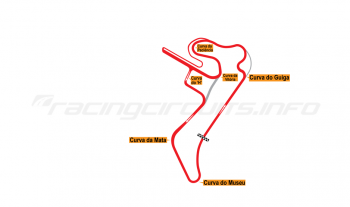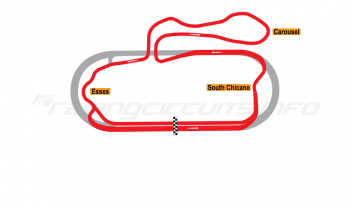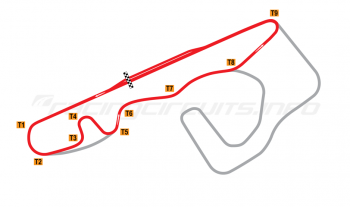Homestead-Miami Speedway
Circuit Overview
Homestead-Miami Speedway is a familiar part of the NASCAR racing calendar, having held the season finale for many years. However, the 1.5 mile speedway has had a varied programme of action over the years, including international visitors from the FIA GT Series to use the infield road course.
Few oval tracks have seen as much re-configuration in such a short space of time as Homestead-Miami. Originally rectangular course - essentially a scaled-down Indianapolis - the layout proved tough for racing and gave safety concerns and was torn down after a year. A more standard 'paperclip' layout resulted, but the relatively flat banked corners still failed to produce great racing.
Now the course has variable banking from 18-20 degrees and the racing is much improved. Today the track hosts all three of NASCAR's series, alongside a calendar of other events, including athletic events for triathletes and endurance enthusiasts.
Circuit History
The Homestead-Miami Speedway owes its existence to a natural disaster; building the circuit was a key part of plans to help the city of Homestead rebound after the devastation caused by Hurricane Andrew.
Longtime Miami motorsports promoter Ralph Sanchez struck a deal to build the 434-acre facility and groundbreaking began August 24, 1993, exactly one year after the hurricane. Sanchez had considerable experience of promoting successful sportscar events at the Bicentennial Park temporary course and, in the runup to the new oval opening, a further Indycar race was organised on the street circuit to help build interest among local fans.
Multiple changes needed to fix problem designs
The track opened in November 1995 as a four-turn, rectangular-oval, based on the Indianapolis Motor Speedway's layout. The first event was the Jiffy Lube Miami 300, the last round of the NASCAR Busch Series. After a ceremonial ribbon cutting, sold out crowds watched Dale Jarrett race to victory. CART Indycars debuted the following spring, Jimmy Vasser taking victory in what was to be a championship year for the American driver.
The new facility was a colourful addition to the racing scene, thanks to its brightly painted buildings and walls, which mirrored the aqua, purple and silver art deco style of old Miami. But there was a significant problem; the racing, in truth, wasn't very good. The Indianapolis-style four cornered layout didn't scale well down to Homestead's smaller size. Instead, the sharp, flat turns and aprons made passing difficult and lowered overall speed. There were also concerns as to the crash angles that the geometry created.
In a bid to correct these problems, in 1996 the aprons of the turns were widened by as much as 24 feet (7.3m), but this did little to significantly improve the racing. Tragedy followed during the 1997 Craftsman Truck race when John Nemechek, younger brother of NASCAR races winner Joe Nemechek, died following a collision at Turn One. Following the collision, $8.2 million was spent in the summer of 1997 to tear down the corners and turn the course to a more traditional continuous-turn oval with six-degree banking. Amid emotional scenes, Joe Nemechek ran out the winner on the remodelled course in the Busch Series race that November.
Road course gains traction
Track action wasn't, however, simply confined to the oval; from the outset, Homestead had benefited from a European-style road course within the oval infield. This did not use any part of the oval banking, so was unaffected by the 1997 remodelling. While perhaps not having the challenge of a Road America or Laguna Seca, it did nevertheless draw favour from many drivers.
The road course also drew some early (and unusual for a US circuit) international attention, when the FIA GT Series paid a visit in both 1998 and 1999. Klaus Ludwig and Ricardo Zonta took victory in 1998 in the mighty Mercedes-Benz CLK-LM, while the following years race, run to GT2 regulations, saw the works Chrysler team beaten for the only time that year when Paul Belmondo and Emmanuel Clérico took victory in their private Chrysler Viper GTS-R. Since those early days, the road course has settled into hosting Grand-Am events until 2013 and more recently the Trans-Am series. In both cases, a new road course configuration using the banking and bypassing the final section of the original road course has been used.
Another rebuilding programme begins
In 2003, the second major rebuilding programme of the oval course commenced, with a $12 million re-banking project that transforms the track from a flat 6-degrees to a computer-designed 18-to-20-degree variable banking system in the turns. The renovations were praised by fans, and the track has produced a number of close finishes. In 2005 night lighting was also installed and Turn One tower opened, housing the Champions Club premium-seating level and private suites.
Sadly, two more fatalities have been recorded at the track since its reconfiguration; Indycar driver Paul Dana suffered fatal injuries in the warmup session before the 2005 race, when he was involved in a high-speed collision after being unable to avoid the crashed car of Ed Carpenter. Then in 2007 Jeff Clinton died in practice for a Grand Am sports car event when his car overturned at Turn One of the road course. In neither case was the track configuration a factor.
A new 18,000 square-foot, two-story media facility was completed in October 2008, while the following year saw a state-of-the-art new scoring tower added, complete with LED displays providing high-resolution graphics and easy-to-view statistical information.
Jump onboard
Circuit info
- Homestead-Miami Speedway, One Ralph Sanchez Speedway Boulevard, Homestead, Florida 33035-1501, USA
- +1 305 230 5000
- Email the circuit
- Official website
Rate This Circuit
Votes: 5391
Plan a visit
Get your race tickets!
Brought to you with: 
We've teamed up with Motorsports Tickets to bring you the best deals for Formula One, MotoGP, Le Mans and more.














